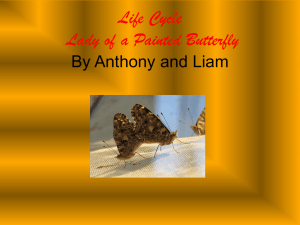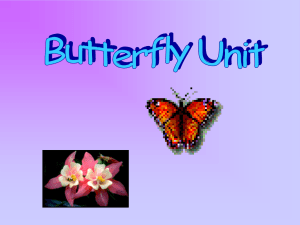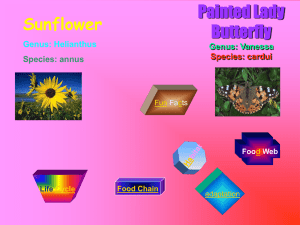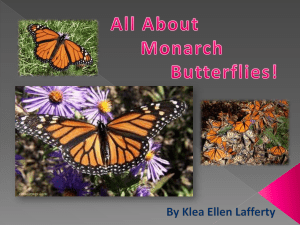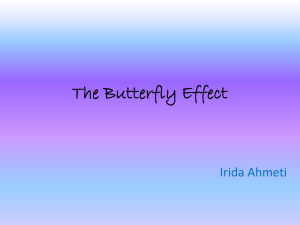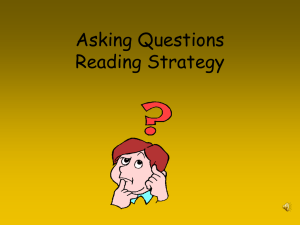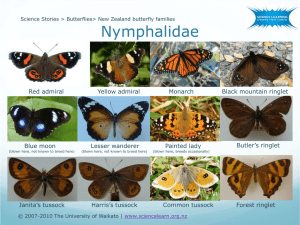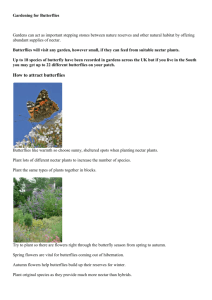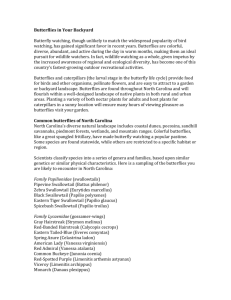Natural Selection Lab - candycorn, m
advertisement
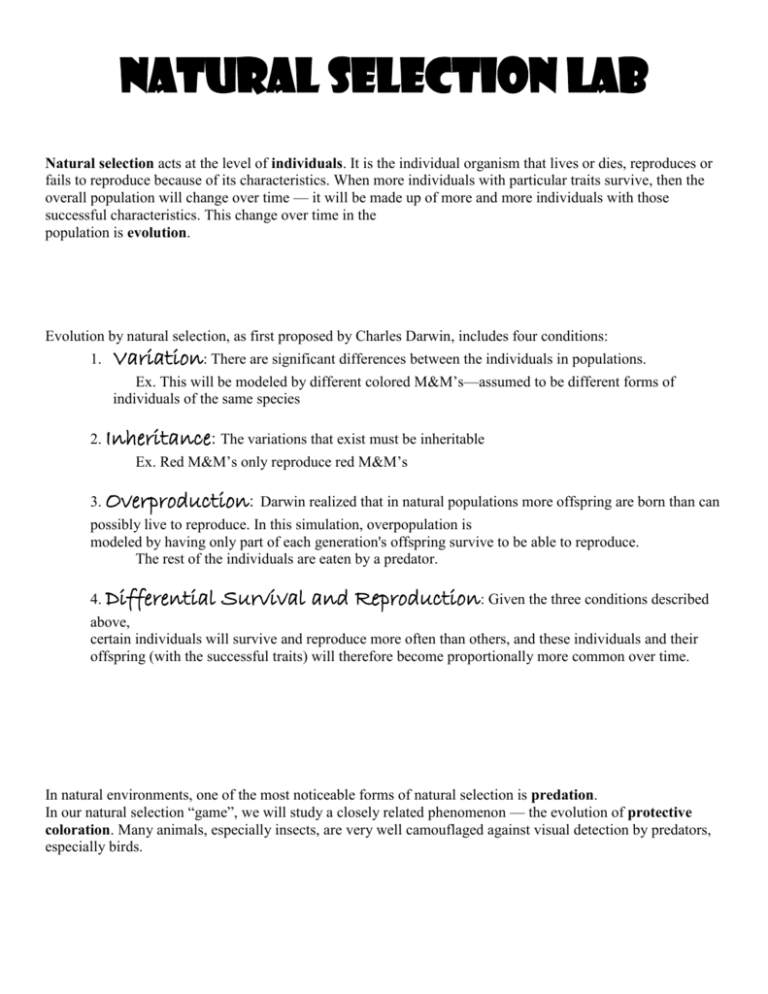
NATURAL SELECTION LAB Natural selection acts at the level of individuals. It is the individual organism that lives or dies, reproduces or fails to reproduce because of its characteristics. When more individuals with particular traits survive, then the overall population will change over time — it will be made up of more and more individuals with those successful characteristics. This change over time in the population is evolution. Evolution by natural selection, as first proposed by Charles Darwin, includes four conditions: 1. Variation: There are significant differences between the individuals in populations. Ex. This will be modeled by different colored M&M’s—assumed to be different forms of individuals of the same species 2. Inheritance: The variations that exist must be inheritable Ex. Red M&M’s only reproduce red M&M’s 3. Overproduction: Darwin realized that in natural populations more offspring are born than can possibly live to reproduce. In this simulation, overpopulation is modeled by having only part of each generation's offspring survive to be able to reproduce. The rest of the individuals are eaten by a predator. 4. Differential Survival and Reproduction: Given the three conditions described above, certain individuals will survive and reproduce more often than others, and these individuals and their offspring (with the successful traits) will therefore become proportionally more common over time. In natural environments, one of the most noticeable forms of natural selection is predation. In our natural selection “game”, we will study a closely related phenomenon — the evolution of protective coloration. Many animals, especially insects, are very well camouflaged against visual detection by predators, especially birds. HOW TO PLAY THE GAME In this game/simulation, M&M’s of different colors represent butterflies. The different colors represent different color variations within one species of butterfly. We will begin with equal numbers of each color butterfly (each M&M) at the start of the game. It is assumed that the different colors are inherited genetically. Step 1: Divide into two-person teams. Each team will begin with an “environment” of candy corns (representing the colors of the leaves and flowers). One person should be designated as the first “Butterfly Predator”. The Butterfly Predator should not be allowed to see what goes on in Step 2, in order that her/his "predation" remain unbiased. Step 2: The other team member should count out four butterflies (M&M’s) of each color — this is the starting population for your environment — Generation #1. Record that in the data table. This same person should then randomly scatter these M&M’s into the candy corns. (This shows how butterflies are randomly dispersed in an environment.) Since there are six colors, there will be a total of twenty-four butterflies in to start with. This is the maximum population of butterflies your environment can support — the “carrying capacity”. Step 3: The Butterfly Predator should now capture twelve butterflies by picking up 12 M&M’s as quickly as possible, one at a time. Also, it is important that the Butterfly Predator break eye contact with the environment after each pick (look away from the tray and then down again before each hunt). Be sure to pick the very first butterfly that you see! After all, time is energy (you're hunting, remember!), and so you can't afford to waste either time or energy by being too picky. Put your "eaten" butterflies away; they have been removed from the population and do not get to reproduce. Step 4: Now collect your surviving butterflies (M&M’s) from the plate. Be sure to get all of them. There must be 12 surviving butterflies. Step 5: Each surviving butterfly (M&M’s) now reproduces. For each surviving butterfly, add one M&M of the same color— your butterflies have now reproduced! So now you will have 24 butterflies again. This is Generation #2. Count your butterflies and record the number of each color variant for Generation #2 only in the Butterfly Predator’s data table. (Notice that there may not necessarily be the same number of each color any more — natural selection has been at work in your population of individuals!) Step 6: For all the next rounds (Generations #2-#4), the Butterfly Predator remains the same person. The other team member should again randomly scatter the new generation of 24 butterflies in the environment and repeat the above steps. Continue until you have completed all generations. Record the data in the Butterfly Predator’s data table. Name _______________________________________________________________Date _______Per _____ DATA COLLECTION 1. Write down your prediction of which color of this species of butterfly will best be able to survive in this environment. _____________________________ 2. Record your raw data in the Butterfly Predator table below: Color Variants 1 red 4 2 3 4 24 24 24 yellow blue orange brown green TOTALS 24 4. Graph your data using a line graph below. Label the x and y axis. SUMMARY QUESTIONS 1. How many butterflies of each color did you start with in Generation #1? ____________________________ 2. Did the number of each color stay the same from generation to generation? Explain. ________________________________________________________________________________________ 3. a. Which color was the most fit in this environment? __________________________ b. What will most likely happen to this most fit color gene since it has such a high survival rate? ___________________________________________________________________________________ c. How many of this “fit” color did you start with in Generation #1? ___________________________________ d. How many of this color did you end up with in Generation #4? _____________________________________ f. Suggest a possible explanation of why this color was more fit in this environment using the definition of fitness and adaptations. _________________________________________________________________________________________ _________________________________________________________________________________________ 4. a. Which color was the least fit in this environment? __________________________ b. How did you determine that? ________________________________________________________________ c. How many of this color did you start with in Generation #1? ______________________________________ d. How many of this color did you end up with in Generation #4? _____________________________________ f. Suggest a possible explanation of why this color was less fit in this environment. __________________________________________________________________________________________ __________________________________________________________________________________________ Post-Lab “Thought Experiments” 1. What if the red butterflies made the predator very ill, and it learned to stay away from them, and there also was a new group of butterflies very similar in color (a close red-orange color). What would happen to the redorange butterflies? Explain your answer. __________________________________________________________________________________________ __________________________________________________________________________________________ __________________________________________________________________________________________ __________________________________________________________________________________________ 2. Consider the results in this lab. Did any of the butterflies survive because they chose to be the more fit color? What did you learn about how evolution works from this lab? __________________________________________________________________________________________ __________________________________________________________________________________________ __________________________________________________________________________________________ __________________________________________________________________________________________ 3. Use what you know about Darwin’s theory of natural selection to apply to a real-life event. In terms of his theory, explain how bacteria can become resistant to antibiotics? _________________________________________________________________________________________ _________________________________________________________________________________________ _________________________________________________________________________________________ _________________________________________________________________________________________

